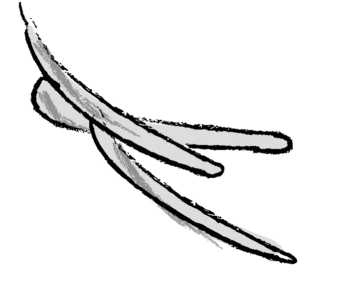Jewish Cooking Boot Camp: The Modern Girl's Guide to Cooking Like a Jewish Grandmother (7 page)
Read Jewish Cooking Boot Camp: The Modern Girl's Guide to Cooking Like a Jewish Grandmother Online
Authors: Andrea Marks Carneiro
Tags: #Cookbooks; Food & Wine, #Entertaining & Holidays, #Special Diet, #Kosher, #Special Occasions, #Religion & Spirituality, #Judaism
COOKING TIME: 3-4 HOURS
1. Spray a large pot with cooking spray and add the oil. Brown the onion, garlic, and beef
until the meat is well browned.
2. Add the water and tomatoes. Bring to a boil and simmer for 1 hour.
3. Add the celery, carrots, zucchini, broccoli, cauliflower, corn, and string beans. Bring to a
boil, add salt, and simmer for 3 hours.
4. If the soup is too thick and you prefer a thinner soup, add enough beef broth to get the consistency you like.
5. Traditionally, we remove the beef prior to serving the soup, but you can serve it in the
soup or alongside.
* This soup freezes well.
"My mom's family is Jamaican so she likes to incorporate some of her culture ... that
explains why we always have rice and peas at Jewish holidays!"
-SUZANNE, NEW YORK CITY, NEW YORK
"My family is weirdly musical, and my grandfather made up a silly song about matzo balls
that he would sing when we made them and, of course, ate them. Even though he passed
away, the song lives on and we always sing it when we have matzo ball soup at Jewish
holidays!"
-ALEESA, COCONUT GROVE, FLORIDA

Simple, easy, and always delicious, fresh string beans are an easy addition to any menu when
you need an extra veggie.
COOKING TIME: 10 MINUTES
1. Rinse the string beans and cut off both ends.
2. Put the beans in a steamer basket over cold water in a large pot and bring the water to a
boil.
3. Cover the pot and turn the heat off. Let the beans steam for 8 to 10 minutes. (They should
be crunchy and bright green.)
4. Drain the water and put the beans back in the pot.
5. In a small bowl, mix together the softened margarine and mashed garlic.
6. Stir this mixture into the hot beans. Add salt to taste.
If you don't love garlic, you can also prepare this dish a la our friend Susie: Saute fresh
green beans with just a bit of olive oil and throw in some almond slivers. So delicious!

Once and for All: The Sounds of Shofar
The tekiah is a single blast.
The shevarim is a set of three blasts.
The teruah is a set of nine very short blasts.
A true classic in Jewish cooking, this traditional dish is sure to bring back many memories for
young and old alike. This noodle pudding, created by Roz's sister (who happens to be
a phenomenal cook), is our favorite.
COOKING TIME: 45 MINUTES
1. Preheat the oven to 350°F.
2. Grease a 2-quart casserole dish, using butter or cooking spray.
3. Boil the noodles, following the directions on the package to cook them al dente.
4. When the noodles are cooked, drain them well.
5. Combine the remaining ingredients in a large bowl and mix thoroughly.
6. Pour the mixture into the greased casserole dish.
7. Bake for 45 to 55 minutes or until golden brown on top.
Grandma Edith liked food with a kick. She was creative in the kitchen, always subbing this
for that and adding seasoning here and there. For her famous brisket recipe she subbed red wine
for water. She also always plugged the brisket with garlic the night before cooking to add some
extra flavor. The result was a brisket that we still crave to this day and one that is at the center
of almost all our holiday menus.
COOKING TIME: 4 HOURS
1. Slice the garlic clove into 6 or 7 thin pieces and "plug" them into the brisket. To do this,
make 6 to 7 little cuts into the brisket and stuff the garlic slivers into them.
2. Place the brisket in a dish or plastic storage bag and pour %4 cup red wine over it. Marinate
overnight.
3. The next morning preheat the oven to 325°F. and remove the brisket from the wine.
Sprinkle with salt and pepper. Add oil to a skillet and brown all sides of the brisket.
4. Place the brisket in a roasting pan (fatty-side down) and add the carrots. Pour the dry
onion soup mix over the brisket along with 3/ cup of red wine. Cover tightly with foil.
5. Bake for 31 hours, then check the brisket for doneness. If the beef is tender, it's ready; if
not, put it back in the oven for another 30 to 45 minutes.
6. Let the brisket cool before slicing. Use the juices in the pan as gravy.
* Buy the first-cut brisket, as it is leaner. It is a little more expensive but well worth it.
* Use Mogan David or Manischewitz wine as these are sweeter than other red wines.
The Burning Questions: Everything You Ever Wanted to Know About Brisket
(Courtesy of Byron Goldenhersh, president, Saveway Food Company, St. Louis)

First, the quality should be choice grade or better, not necessarily prime (too fat), but for
extra-high quality one can ask for CAB beef, which most high-end stores like Whole Foods
carry. It's an industry acronym and stands for "Certified Angus Beef," which is considered
one of the highest-quality breeds of cattle.
Next, decide whether to purchase a whole brisket or just the flat cut. The whole brisket has the fattier "point" portion with a lot of deckle fat, which needs to be removed, along
with the outside fat, which needs to be trimmed to 1/s inch or less, along with the leaner
flat portion. Whole briskets weigh about 9 to 12 pounds untrimmed. However, the "point
cut portion" is extremely heavily marbled (fat grain), going through the entire point portion
of the brisket. When customers at the deli say "that corned beef is too fatty," chances are
it's from the point cut. (FYI: The point is primarily used in pastrami, which is traditionally
fattier than corned beef, because most customers want their corned beef lean, which comes
from the "flat" portion of the brisket. In Jewish delis or kosher-style delis, only brisket is
used in making corned beef or pastrami.)
The brisket flat cut is primarily what the shopper sees in the supermarket. It will
weigh approximately 4 to 6 pounds and will be lean; only a little trimming of excess fat on
the cap and sides will be needed. Once the brisket has been slow-roasted to perfection, it
will only be tender if it is sliced correctly. Brisket must be sliced thinly and against the
grain. If brisket is not sliced against the grain, it will be tough rather than tender.
It's not Rosh Hashanah without a honey cake. This traditional dessert is a staple of the holiday
and would be sorely missed from any menu.
COOKING TIME: APPROXIMATELY 1 HOUR